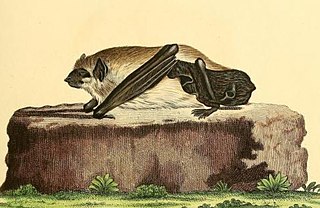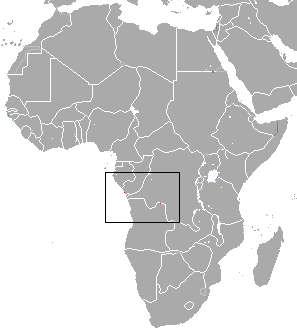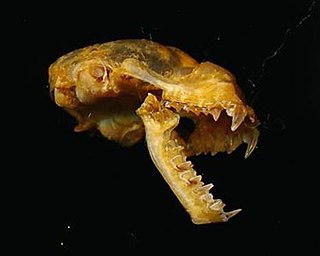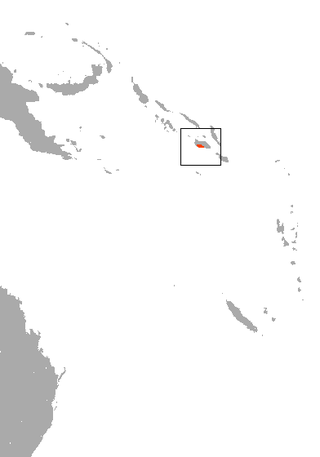
The Natal free-tailed bat is a species of bat in the family Molossidae, the free-tailed bats. It is endemic to the island of Mauritius. It is known from fewer than five locations in its range, but it is common at a few sites. It roosts in caves, and it is considered to be an endangered species due to disturbance of its cave habitat.

Allen's striped bat is a species of bat in the family Vespertilionidae, the vesper bats. It is native to Africa, where it occurs in Cameroon and the Democratic Republic of the Congo. This species can be found in lowland tropical moist forests. Little else is known about it.

Allen's spotted bat is a species of vesper bat in the family Vespertilionidae found in the Central African Republic, the Democratic Republic of the Congo, Kenya, and Uganda. It is found in subtropical or tropical moist lowland forests.

Schreber's yellow bat or the giant house bat, is a species of vesper bat. It is found in Benin, Democratic Republic of the Congo, Ivory Coast, Ghana, Kenya, Malawi, Mozambique, Nigeria, Senegal, Tanzania, Togo, and Zimbabwe. Its natural habitats are subtropical or tropical moist lowland forests, dry savanna, and moist savanna. It is an uncommon species and its biology is poorly known. It was first described in 1774 by the German naturalist Johann Christian Daniel von Schreber, who named it Vespertilio nigrita. It was later transferred to the genus Scotophilus, making it Scotophilus nigrita.

Anchieta's serotine, formerly known as Anchieta's pipistrelle, is a species of vesper bat. It is found in Angola, Democratic Republic of the Congo, South Africa, Zambia, Zimbabwe and Madagascar. The species inhabits savanna habitats.
Duke of Abruzzi's free-tailed bat is a species of bat in the family Molossidae. It is found in Cameroon, Central African Republic, Democratic Republic of the Congo, Ivory Coast, Gabon, Ghana, South Sudan, and Uganda. Its natural habitats are subtropical or tropical dry forest, subtropical or tropical moist lowland forest, and moist savanna. It is threatened by habitat loss.

The northern free-tailed bat is a species of bat in the family Molossidae. It is found in Indonesia and Malaysia.
The lappet-eared free-tailed bat is a species of bat in the family Molossidae. It is found in Benin, Burkina Faso, Democratic Republic of the Congo, Ivory Coast, Ghana, Guinea, Kenya, Liberia, Mali, Niger, Nigeria, Sudan, Tanzania, Togo, and Uganda. Its natural habitats are dry savanna and moist savanna.

The Nigerian free-tailed bat is a species of bat in the family Molossidae. It is native to two widely separated parts of Africa, and is sometimes considered to represent two separate species.

The São Tomé free-tailed bat is a species of bat in the family Molossidae. It is endemic to São Tomé and Príncipe. Its natural habitats are dry savanna, moist savanna, and plantations. It is threatened by habitat loss. Only three individuals have ever been documented.

The lesser Angolan epauletted fruit bat is a species of megabat in the family Pteropodidae. It is found in Angola and the Republic of the Congo. Its natural habitats are subtropical or tropical dry and moist lowland forest, and savanna.

The Aba roundleaf bat, also known as the Aba leaf-nosed bat is a species of bat in the family Hipposideridae. It is found in West Africa along the southern coast from Nigeria to Senegal. Populations have also been noted in Sudan and Uganda. Its natural habitats are subtropical or tropical moist lowland forests, dry and moist savannas, and caves.

The Benito roundleaf bat is a species of bat in the family Hipposideridae found in Cameroon, Central African Republic, Republic of the Congo, Democratic Republic of the Congo, Ivory Coast, Equatorial Guinea, Gabon, Ghana, Guinea, Liberia, Nigeria, Sierra Leone, South Sudan, and Togo. Its natural habitat is subtropical or tropical moist lowland forests.

The short-tailed roundleaf bat is a species of bat in the family Hipposideridae. It is found in Cameroon and Equatorial Guinea. Its natural habitats are subtropical or tropical moist lowland forests and caves. It is threatened by habitat loss.

The Trevor's free-tailed bat is a species of bat in the family Molossidae. It is found in Central and West Africa. Its natural habitats are subtropical or tropical dry forests and moist savanna.

The Bini free-tailed bat is a species of bat in the family Molossidae found in West and Central Africa. Its natural habitat is subtropical or tropical moist lowland forests.
The big-eared mastiff bat is a species of bat in the Molossidae family endemic to Papua New Guinea. It is only known from eleven specimens and it is not easy to survey. It forages in rainforest canopy and roosts in tree hollows. It is likely more widespread than currently known but additional research is needed.

Decken's horseshoe bat is a species of horseshoe bat. It is found in Kenya and Tanzania. Its natural habitats are tropica and subtropical moist lowland and montane forest, moist savanna, caves and other subterranean habitats.

The montane monkey-faced bat or montane flying monkey is a megabat endemic to the Solomon Islands. It is listed as a critically endangered species. Due to its imperilled status, it is identified by the Alliance for Zero Extinction as a species in danger of imminent extinction. In 2013, Bat Conservation International listed this species as one of the 35 species of its worldwide priority list of conservation. Only one individual has ever been found.
Chaerephon atsinanana is a free-tailed bat found on Madagascar. It was considered a subspecies of the little free-tailed bat until 2010. During the day, they are known to roost in man-made structures such as the roofs or attics of buildings.



















